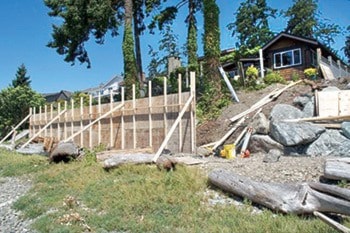Work on a new sea wall near the shores of Roberts Bay in Sidney has been allowed to resume Tuesday morning, after being ordered to stop over the weekend by the municipality until its approval process was reviewed by the town’s legal team.
With that advice back to the town Tuesday morning, Chief Administrative Officer Randy Humble issued a statement, rescinding the stop work order and outlining the steps the municipality took before granting the property owner permission to build a poured concrete sea wall.
Biologist Kerry Finley, who lives on the shores of the bay and across from the property where the sea wall is under construction, is concerned the wall encroaches upon the Shoal Harbour Migratory Bird Sanctuary. He has asked the Town of Sidney to put a stop work order on the site until the wall’s location can be verified and the town’s own approvals process can be scrutinized. Finley says he thinks the town did not follow its own rules in this case, and that could cause damage to the habitat in Roberts Bay.
“The town clearly violated its own policies and procedures,” Finley said, adding he thinks there have also been breaches of the Migratory Bird Act as well as Department of Fisheries and Oceans and provincial regulations.
Randy Humble, the town’s chief administrative officer, says the municipality had asked for the work to stop while they investigated what happened, but he said they followed their policy in this case.
“It is under review,” Humble told the News Review Monday afternoon. “Our legal team is looking at it, to confirm that the town took the right steps.”
Humble said the town’s policy on sea wall construction calls for the use of rip rap — or large boulders — in most cases.
He said variations are allowed — such as a concrete wall as is the case here — if an engineer states that it will not have an impact. The property owner, Humble said, hired an engineering firm that reported the use of rip rap would not be feasible due to access issues and expense. The town did, Humble said, approve a pour-in-place concrete wall.
As for concern that the sea wall encroaches on the sanctuary boundary, Humble said they had a surveyor repeat a review of the site after Finley raised the issue. Humble said the surveyor confirmed the wall is located on private property and is not encroaching on the sanctuary boundary.
The town further received sealed drawings of the sea wall design during its approvals process, as well as input from engineers, the Department of Fisheries and Oceans and others. Most recently, Humble said the B.C. Ministry of Forests, Lands and Natural Resource Operations said the matter is not an issue for them.
“We do take these concerns seriously,” Humble said. “We are waiting for confirmation from our legal team and until then, we will keep the stop work order on the (sea wall).”
Finley said he has forwarded his concerns on to the Canadian Wildlife Service, including his photos of the property from last year and this weekend. He said he’s leaving it up to them whether they can take action to stop the construction. The News Review has called the Canadian Wildlife Service for comment on the case. Humble also told the News Review on Tuesday that he had been contacted by a CWS investigator.
Finley said he’s frustrated by the continued building near the sanctuary, which he said has an impact on the habitat for migratory birds that regularly use the area to feed during their long journeys.
“Sea walls are known to cause serious erosion issues,” Finley said. “I feel it will contribute to the ongoing destabilization of the area and its habitat.
“I’ve been part of the effort to deal with this for the last 25 years,” he continued, “working with private property owners and the town to try to save the sanctuary.”
